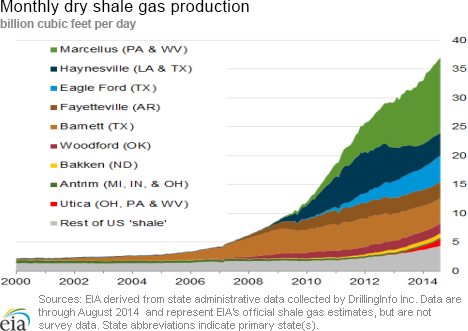In the News:
FERC approves New England's 2014-15 winter reliability program, but challenges remain
Last week, the Federal Energy Regulatory Commission (FERC) issued an order accepting the proposed 2014-15 winter reliability program (WRP) and associated tariff revisions filed by the New England Power Pool (Nepool) and the Independent System Operator of New England (ISO-NE), the power grid operator for New England.
The 2014-15 WRP, which is intended to be a temporary measure to ensure that there will be adequate fuel supplies to meet regional needs, was similar to the 2013-14 WRP. While Nepool and ISO-NE hoped to avoid issuing a second WRP, more recent market events led them to issue the order, including the retirement of nongas generators and anticipated problems replenishing oil inventories midseason.
Like the 2013-14 WRP, the program this year creates incentives for dual-fuel resource capability and participation, offsets the carrying costs of unused firm fuel purchased by generators (i.e., oil and liquefied natural gas), and provides compensation for demand-response services. As part of the acceptance of this year's WRP, FERC requested that the ISO-NE initiate a stakeholder process to develop a proposal to address reliability concerns for the 2015-16 winter and future winters.
Natural gas consumption in New England has grown over the last decade, with increased gas consumption in the electric power sector driving much of the growth. In 2013, gas-fired generation accounted for 45% of the electricity produced in the region (compared with 29% in 2001). The lack of corresponding growth in pipeline capacity into the region, coupled with declining levels of imports, causes the price of gas and electricity to rise during peak demand days.
On average, over the past five winters (November-March), New England consumed 140 billion cubic feet (Bcf) of natural gas for power generation and 148 Bcf in the residential sector. Last winter, residential natural gas use rose to 171 Bcf because of persistently cold weather. The lack of available low-cost natural gas caused utilities to shift to more expensive fuels and away from natural gas generation, which reduced natural gas consumption for power generation last winter to 107 Bcf. This lowered natural gas to approximately 30% of the generated electrical power, even though natural gas-fired power plants represented 47% of ISO-NE's capacity.
There are several planned pipeline projects that are designed to add capacity to the region. Additionally, earlier this week, Spectra Energy and Northeast Utilities announced details of their Access Northeast project. This $3 billion project includes providing "scalable expansion of existing pipeline infrastructure, which is attached to approximately 60% of ISO-NE's natural gas generation capacity," according to their press release.
Overview:
(For the Week Ending Wednesday, September 17, 2014)
- Prices generally fell in the Northeast but rose moderately across most of the rest of the country. The Henry Hub spot price was nearly flat, gaining a penny from $3.96 per million British thermal unit (MMBtu) last Wednesday, September 10, to $3.97/MMBtu yesterday, September 17.
- At the New York Mercantile Exchange (Nymex) the price of the near-month (October 2014) contract rose from $3.954/MMBtu last Wednesday to $4.013/MMBtu yesterday.
- Working natural gas in storage rose to 2,891 Bcf as of Friday, September 12, according to the U.S. Energy Information Administration (EIA) Weekly Natural Gas Storage Report (WNGSR). A net increase in storage of 90 billion cubic feet (Bcf) for the week resulted in storage levels 12.2% below year-ago levels and 13.3% below the five-year average for this week.
- The total rig count was 1,931 as of Friday, September 12, according to data from Baker Hughes Inc. This represents an increase of 6 from the previous week, and rigs are 163 units greater than last year's level. The natural gas rig count declined by 2 units to 338, and is 63 rigs below year-ago levels. The oil rig count rose by 8 to 1,592, and is 231 units greater than last year.
- The Mont Belvieu natural gas plant liquids composite price rose 0.9% to $9.75/MMBtu for the week covering September 8- September 12. The natural gasoline price fell 2.4%, while the prices of ethane, propane, and butane rose 3.3%, 2.9%, and 0.5%, respectively. Isobutane prices were flat.
Prices/Demand/Supply:
Weather is moderate, prices are mixed. Outside the Northeast, prices ended the report week moderately higher, while most price points in the Northeast experienced significant declines. Henry Hub prices remained below the $4/MMBtu threshold as overall temperatures were mild and demand was moderate.
Prices rise Monday and Wednesday. Significant price increases on Monday and Wednesday were balanced by more moderate but steady declines earlier in the report week. Henry Hub spot prices fell to $3.81/MMBtu on Friday, September 12, but gained 10 cents on Monday and 12 cents on Wednesday to end the week at $3.97/MMBtu, just 1 cent higher than it began the week. There was little in the way of weather to explain the price increases, as temperatures remain mild across most of the country. Part of Monday's price rise could be explained as a reaction to a Gulf of Mexico explosion over the weekend on a gathering pipeline that delivers gas into Henry Hub. While one person was killed in the explosion and two others injured, the disruption to gas flows was minimal.
Northeast spot prices generally fall. In the Northeast, prices at most market and production areas declined. At the Algonquin Citygate, which serves Boston consumers, prices fell from $3.25/MMBtu last Wednesday to $2.64/MMBtu yesterday. New York prices on Transcontinental Pipeline's Zone 6 fell from $3.06/MMBtu to $2.47/MMBtu. Prices on Tennessee Pipeline's Zone 6 200L line (which runs through Massachusetts, Rhode Island, and New Hampshire) were the only notable exception, increasing from $3.19/MMBtu last Wednesday to $3.52/MMBtu yesterday.
Marcellus prices remain low. Prices in the Marcellus Shale region remained low compared to most markets. At Tennessee Pipeline's Zone 4 Marcellus trading point, located in northeast Pennsylvania, prices fell from $2.64/MMBtu on Wednesday to $1.94/MMBtu on Friday, but rebounded to end the report week at $2.24/MMBtu.
Nymex prices increase. At the Nymex, the price of the near-month (October 2014) contract rose by 5.9 cents/MMBtu, from $3.954/MMBtu last week to $4.013/MMBtu yesterday.
Supply falls slightly while demand increases. Supply fell by 0.2% this week as imports declined. Dry production increased by 0.2%, and remains 7.2% greater than year-ago levels. Imports from Canada declined week-over-week by 5.5%, and LNG sendout remained at minimal levels. Total consumption increased 1.3%, led by an increase in residential/commercial consumption. Driven by increased demand in the Midwest, residential/commercial consumption reached its highest levels since mid-May, according to data from Bentek Energy.
Storage
Net injections into storage much higher than average. The net injection reported for the week ending September 12 was 90 Bcf, 19 Bcf larger than the five-year average net injection of 71 Bcf and 42 Bcf larger than last year's net injection of 48 Bcf. Working gas inventories totaled 2,891 Bcf, 401 Bcf (12.2%) less than last year at this time and 444 Bcf (13.3%) below the five-year (2009-13) average.
Storage build is similar to market expectations. Market expectations called for a build of 90 Bcf. When the EIA storage report was released at 10:30 a.m., the price for the October natural gas futures contract fell 6 cents to $3.93/MMBtu in trading on the New York Mercantile Exchange (Nymex).
From the week ending on April 4th through the week ending on September 12, net storage injections totaled 2,069 Bcf versus 1,592 Bcf for the same 24 weeks in 2013, and 1,521 Bcf for these weeks between 2009 and 2013, on average. The average unit value of what storage holders put into storage from April 4 to September 12 was $4.32/MMBtu, 14% higher than the average value for the same 24 weeks last year of $3.79/MMBtu. The highest winter-month Nymex price (for the January 2015 contract) in trading for the week ending on September 12 averaged $4.07/MMBtu. This is 21 cents more than the current front month Nymex contract price for that week. A year ago, the difference was 33 cents/MMBtu, providing a bit more financial incentive to buy and store gas in the summer for sale in the winter.
There currently are 7 more weeks in the injection season, which traditionally occurs April 1 through October 31, although in each of the past 11 years, injections continued into November. EIA forecasts that the end-of-October working natural gas inventory level will be 3,477 Bcf, which, as of September 9, would require an average injection of 84 Bcf per week through the end of October. EIA's forecast for the end-of-October inventory levels are below the five-year (2009-13) average peak storage value of 3,851 Bcf.
All three regions post larger-than-average builds. The East, West, and Producing regions had net injections of 58 Bcf (10 Bcf larger than its five-year average), 7 Bcf (1 Bcf larger than its five-year average), and 25 Bcf (10 Bcf larger than its five-year average), respectively. Storage levels for all three regions remain below their year-ago and five-year average levels.
Temperatures during the storage report week were a few degrees warmer than the 30-year average. Temperatures in the Lower 48 states averaged 71.7 degrees for the week, 2.0 degrees warmer than the 30-year normal temperature and 1.9 degrees cooler than during the same period last year. There were 56 population-weighted cooling degree days during the storage report week, 12 higher than the 30-year normal and 9 lower than the same period last year.
See also:
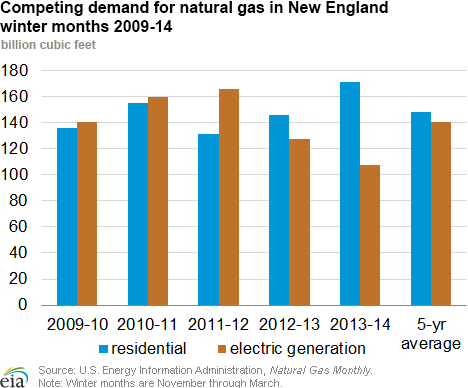
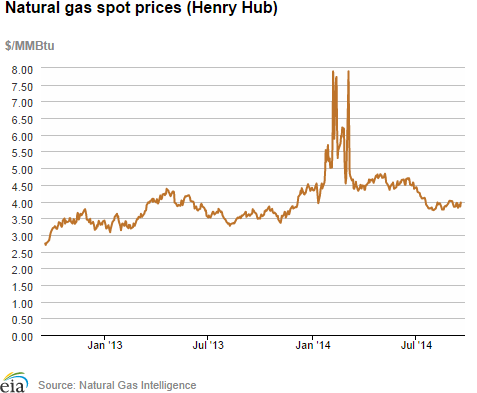
| Spot Prices ($/MMBtu) | Thu, 11-Sep |
Fri, 12-Sep |
Mon, 15-Sep |
Tue, 16-Sep |
Wed, 17-Sep |
|---|---|---|---|---|---|
| Henry Hub |
3.93 |
3.81 |
3.91 |
3.85 |
3.97 |
| New York |
2.53 |
2.05 |
2.56 |
2.54 |
2.47 |
| Chicago |
3.95 |
3.86 |
3.98 |
3.93 |
4.07 |
| Cal. Comp. Avg,* |
4.14 |
4.07 |
4.37 |
4.17 |
4.30 |
| Futures ($/MMBtu) | |||||
| October Contract |
3.823 |
3.857 |
3.931 |
3.995 |
4.013 |
| November Contract |
3.873 |
3.910 |
3.997 |
4.063 |
3.873 |
| *Avg. of NGI's reported prices for: Malin, PG&E citygate, and Southern California Border Avg. | |||||
| Source: NGI's Daily Gas Price Index | |||||
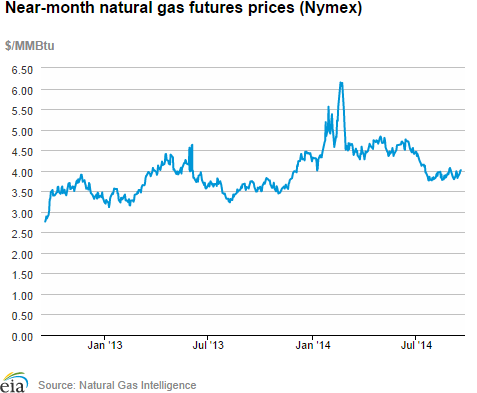
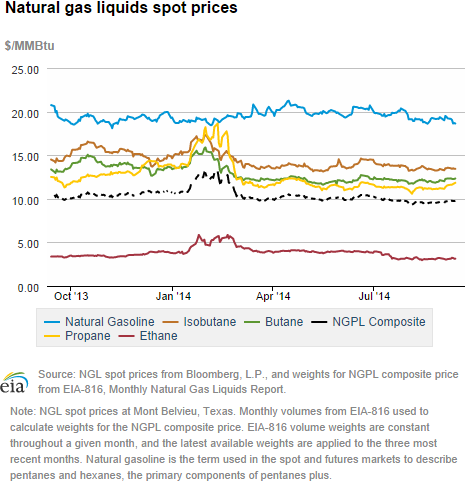
| U.S. Natural Gas Supply - Gas Week: (9/10/14 - 9/17/14) | ||
|---|---|---|
Percent change for week compared with: |
||
last year |
last week |
|
| Gross Production | 7.24%
|
0.18%
|
| Dry Production | 7.17%
|
0.18%
|
| Canadian Imports | -15.11%
|
-5.51%
|
| West (Net) | -21.93%
|
-3.85%
|
| MidWest (Net) | 15.17%
|
0.90%
|
| Northeast (Net) | -246.26%
|
236.46%
|
| LNG Imports | -68.63%
|
-33.58%
|
| Total Supply | 5.17%
|
-0.25%
|
| Source: BENTEK Energy LLC | ||
| U.S. Consumption - Gas Week: (9/10/14 - 9/17/14) | ||
|---|---|---|
Percent change for week compared with: |
||
last year |
last week |
|
| U.S. Consumption | 0.6%
|
1.3%
|
| Power | -10.9%
|
-12.8%
|
| Industrial | 3.8%
|
2.9%
|
| Residential/Commercial | 20.6%
|
32.6%
|
| Total Demand | 1.6%
|
1.0%
|
| Source: BENTEK Energy LLC | ||
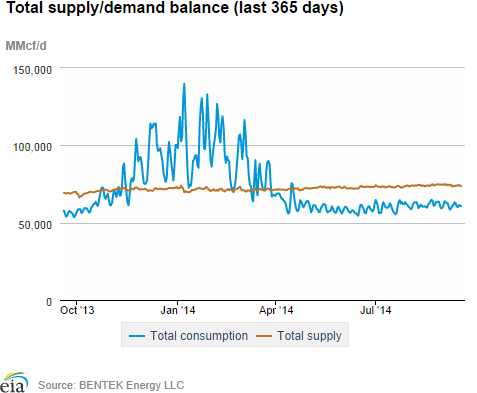
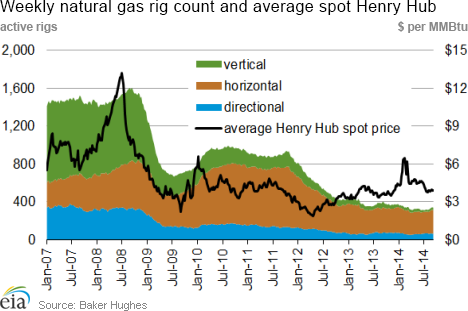
| Rigs | |||
|---|---|---|---|
Fri, September 12, 2014 |
Change from |
||
last week |
last year |
||
| Oil Rigs | 1,592 |
0.51% |
16.97% |
| Natural Gas Rigs | 338 |
-0.59% |
-15.71% |
| Miscellaneous | 1 |
0.00% |
-83.33% |
| Rig Numbers by Type | |||
|---|---|---|---|
Fri, September 12, 2014 |
Change from |
||
last week |
last year |
||
| Vertical | 372 |
1.09% |
-16.22% |
| Horizontal | 1,342 |
0.68% |
24.72% |
| Directional | 217 |
-3.13% |
-12.50% |
| Source: Baker Hughes Inc. | |||
| Working Gas in Underground Storage | ||||
|---|---|---|---|---|
Stocks billion cubic feet (bcf) |
||||
| Region | 2014-09-12 |
2014-09-05 |
change |
|
| East | 1,580 |
1,522 |
58 |
|
| West | 445 |
438 |
7 |
|
| Producing | 866 |
841 |
25 |
|
| Total | 2,891 |
2,801 |
90 |
|
| Source: U.S. Energy Information Administration | ||||
| Working Gas in Underground Storage | |||||
|---|---|---|---|---|---|
Historical Comparisons |
|||||
Year ago (9/12/13) |
5-year average (2009-2013) |
||||
| Region | Stocks (Bcf) |
% change |
Stocks (Bcf) |
% change |
|
| East | 1,682 |
-6.1 |
1,785 |
-11.5 |
|
| West | 510 |
-12.7 |
482 |
-7.7 |
|
| Producing | 1,100 |
-21.3 |
1,067 |
-18.8 |
|
| Total | 3,292 |
-12.2 |
3,335 |
-13.3 |
|
| Source: U.S. Energy Information Administration | |||||
| Temperature -- Heating & Cooling Degree Days (week ending Sep 11) | ||||||||
|---|---|---|---|---|---|---|---|---|
HDD deviation from: |
CDD deviation from: |
|||||||
| Region | HDD Current |
normal |
last year |
CDD Current |
normal |
last year |
||
| New England | 12
|
-5
|
-19
|
24
|
15
|
11
|
||
| Middle Atlantic | 3
|
-8
|
-12
|
32
|
12
|
10
|
||
| E N Central | 18
|
2
|
11
|
22
|
2
|
-32
|
||
| W N Central | 30
|
8
|
30
|
21
|
-8
|
-58
|
||
| South Atlantic | 0
|
-1
|
0
|
86
|
16
|
5
|
||
| E S Central | 0
|
-2
|
0
|
87
|
26
|
2
|
||
| W S Central | 0
|
-1
|
0
|
112
|
17
|
-7
|
||
| Mountain | 19
|
-7
|
17
|
47
|
0
|
-13
|
||
| Pacific | 2
|
-6
|
1
|
55
|
21
|
-6
|
||
| United States | 9
|
-2
|
4
|
56
|
12
|
-9
|
||
|
Note: HDD = heating degree-day; CDD = cooling degree-day Source: National Oceanic and Atmospheric Administration | ||||||||
Average temperature (°F)
7-Day Mean ending Sep 11, 2014
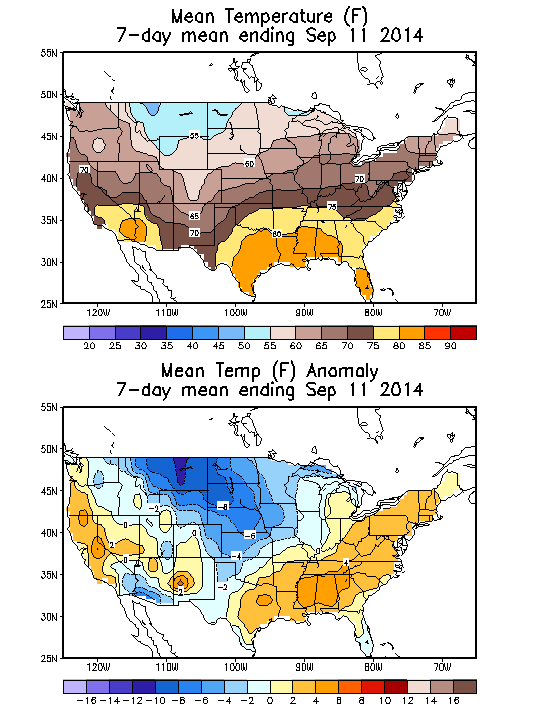
Source: NOAA/National Weather Service
Deviation between average and normal (°F)
7-Day Mean ending Sep 11, 2014

Source: NOAA/National Weather Service

